











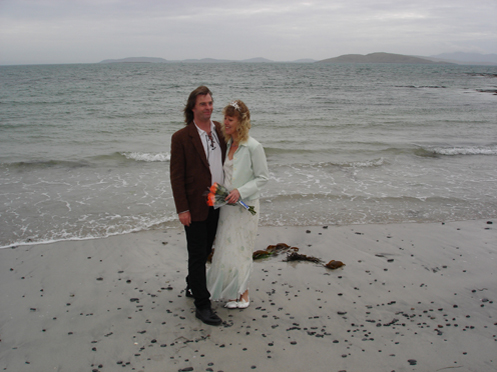
"I have studied you O place,
I have squinted in your mist,
With your sun on my face,
Your softest gentle breath.
Your lips are like diamonds,
And clouds soft and wet,
You love me to love you,
I love you to care.
Your purple mist is passing by,
He has been many times before,
Defusing your light your rainy sky's,
You've the look of the land of lore.
A column of light strikes the sea,
Like a spear upon the sand,
And rich and warm, I’ll always feel,
In the cradle of your hand."

Vertically Polarized Antennas
Richard Feynman & The Pseudo Brewster Angle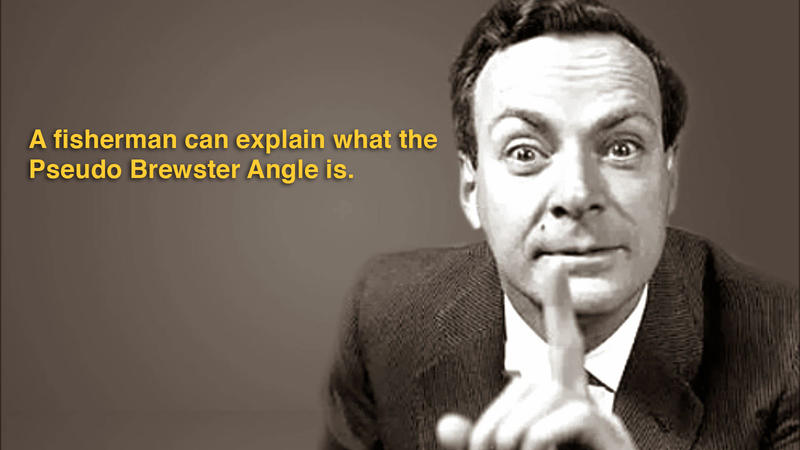
The Brewster angle has to do with figuring out what happens when a "pencil of light" (aka. light beam), let's say traveling
through air, hits some other medium, like water or glass. When it does, part of the light beam is reflected off the
surface of the water or glass, and part of it is refracted by the medium--meaning it passes through the medium.
The angle at which the "pencil of light" strikes the medium determines how much of the light beam ends up reflecting
off the surface of the water or glass, and how much of it ends up passing through the medium as a result of being
refracted by the medium. Another thing that determines the percentages of the light beam that end up being
reflected and refracted is the "index of refraction" of the medium, itself.
Now, when a light beam bounces off of something, or passes through it, the photons don't actually ricochet off
the substance. Or navigate through it, if the substance is translucent. What happens is that the photons are
"absorbed" by the substance. They disappear. They do so by "jiggling" electrons in the substance.
This, in turn, causes the electrons to "re-radiate"--just like the passive elements of a yagi do (e.g. director, reflector).
But in this case the electrons "re-radiate" by emitting another photon. That's how photons are
"reflected" off a substance, or "pass through" a translucent one. It's like a relay race. Photons in the
light beam hit the substance and excite electrons in the substance. These excited electrons then emit photons
in order to return to their lower energy state. These "re-radiated" photons then almost immediately hit another
electron, jiggling it. It emits a photon. This goes on and on and on through the substance until the electrons at the
opposite surface of the substance emit photons which do not strike anymore electrons, but simply continue
uninhibited outside of the substance. This is an over simplification, and assumes the substance is in a perfect vacuum.
But it serves the early stage of our understanding of the Pseudo Brewster Angle.
Now, each time a photon jiggles an electron, certain aspects of the light beam change. One of these aspects is its
polarization. As things turn out, assuming the light beam heading towards the substance is not polarized,
being reflected by the substance polarizes it, and being refracted by the substance also polarizes it, but not so much.
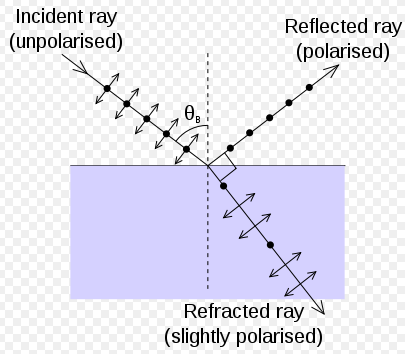
Or the angle the sun has to be at in order for the glare off a window to prevent you from seeing inside a building.
Actually, the Brewster Angle is a lot more intricate than this. Let this simplistic notion suffice on the first pass
of a more thorough explanation. Having said that, if the sun gets lower off the water than the Brewster Angle, it
glare continues to prevent you from seeing into the water. And if you look closely, you will notice that you
cannot see into the water even in parts where the glare of the sun is not reflecting off the surface of the water.
The same holds true if you are underwater. When you look up and away at a certain angle, you cannot see the
sky above you. All you see is a rippling reflection of everything beneath the water. If you look straight up, it
disappears and you can see clearly the sky above. You can see the same thing when looking into an aquarium.
The Brewster Angle is the angle at which total reflection occurs.

You can visualize why RF does this over the ocean's surface by remembering what the ocean looks like on a sunny day.
If the sun is directly overhead, you can look down into the water and see the fishes swimming around. If the sun comes in at an increasingly lower angle, at some point it starts glittering off the surface and you cannot see down into the water.
The sun's light is as much electromagnetic radiation as is the energy radiated by the vertical.
It's just that its frequency is so high,
and its wavelength so short, that the contours of the ocean's waves and ripples--which are
many wavelengths longer than sunlight's--cause the sun's reflection to glitter and sparkle.
In the case of the 7 MHz vertical, its 40 meter wavelength is much larger than the contours of the waves
and ripples of the water. Therefore, at 40 meter resolution, the surface of the ocean appears to
be a flat surface exhibiting high conductivity. At 7 MHz, it acts as a smooth mirror reflecting most of the
negative-angle radiation emitted by the vertical. When this reflected component merges with the vertical's
low-angle lobe--kilometers out in the antenna's far field--it combines constructively, thus enhancing the
low-angle component of the vertical's radiation pattern. Inland, this is not true. Geological formations and
topographical undulations are perceivable at 40 meter resolution. They constitute "ground clutter" to the
negative-angle component of the vertical's radiation. When encountering the poor conductivity of all soil types,
the small amount of this component that makes it way back to the low-angle lobe does not recombine with it.
This is why the antenna modeling plots of verticals situated over soil
never show the low-angle lobe coming all the way down to the X-axis.
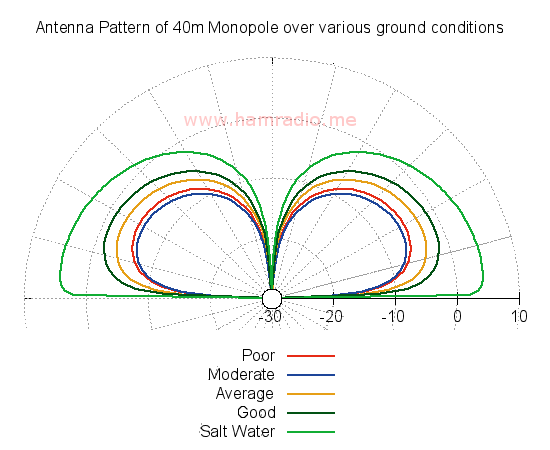

The Ground System Determines How Much Power is Radiated by the Vertical
An old timer summed up the role of a vertical's ground system when stating, "It determines how much powerthe vertical radiates". Another well-known ham equates the ground system as a footing needed by the transmitter
to "push against" when jiggling electrons up and down the vertical element. Others visualize the ground system
as a path allowing for "return currents" radiated by the vertical element to make their way back to the shield of
the coax. Anyway you slice it or dice it, the ground system for Marconi-type antennas, such as verticals, is crucial.
For the verticals that do work well, the operators all testify to the enormous amount of physical work required to
erect them. And this effort is unequally divided between installing the vertical element (easy) and constructing the
ground radial system (hard). Again, most of the time you will spend in the field will be consumed by installing the
ground system. There is a lot of talk in the community about using elevated-radials as a short-cut around putting
in buried radial systems. As few as 2 elevated radials are said to be sufficient to extract some modicum of performance
from a vertical. 4 elevated-radials are heralded as working as well as 32 buried radials. I think such observations
might hold true when the vertical is installed near salt water. Yet, when installed inland, verticals with 2 or 4
elevated-radials did not work as commonly described.

On the surface, the 10m long 40m vertical that’s used on 21.225MHz does indeed look like a cloud burner.
Here it is. 15m band in green -vs- a pure quarter-wave in red).
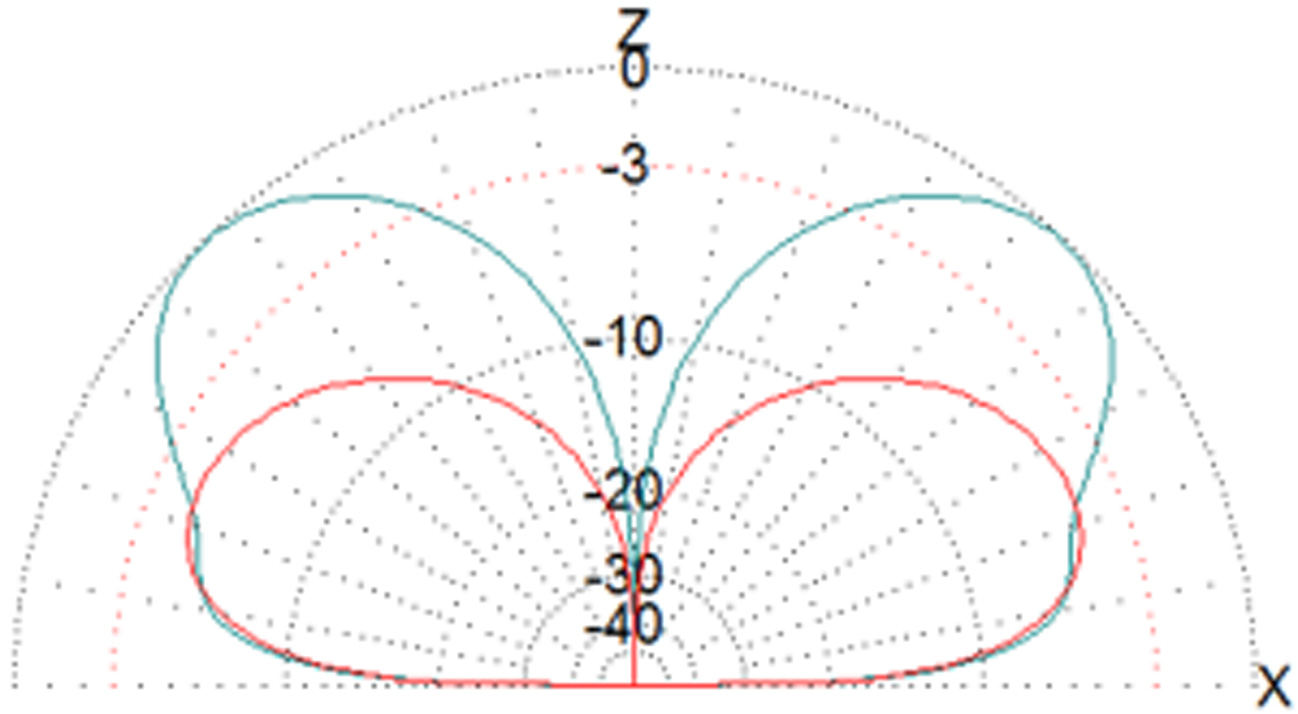
But the usable radiation angle isn’t at 30 or 40 degrees on 15m band, it’s probably more (on average) about 5 degrees off the horizon.
The good news is that the three-quarter-wavelength 15m band antenna actually (very slightly) out-performs a standard quarter-wave by
around 1db at around 3 degrees (although a neat little bit of extra gain also at about 13 degrees too -vs- 1/4 wave).
Wire Antennas for Dummies by Callum, M0MCX
The Half Square, Double Half Square and
Bobtail Curtain Antennas!
By WB3AYW
http://guests.antennex.com/rooms/shack/Mar06/nc.html
http://www.convectiveweather.co.uk/ionosphere/index.php